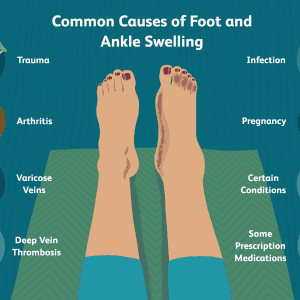Understanding Swollen Ankles: What You Need to Know
Swollen ankles are a common problem that many people experience. They can be caused by various factors, such as fluid retention, injuries, or underlying health conditions. In this article, we’ll explore the causes, symptoms, treatments, and preventive measures for swollen ankles to help you better understand and manage this issue.
Causes of Swollen Ankles
1. Fluid Retention:
Swollen ankles often occur due to excess fluid buildup in the tissues, leading to puffiness and discomfort.
2. Injuries:
Ankle injuries, such as sprains or fractures, can cause swelling around the affected area, impacting mobility and comfort.
3. Venous Insufficiency:
Problems with blood circulation, such as venous insufficiency, can result in fluid accumulation in the lower extremities, including the ankles.
4. Infections:
Infections, such as cellulitis or lymphangitis, can cause inflammation and swelling in the ankles, requiring prompt medical attention.
5. Medical Conditions:
Underlying health issues like heart disease, kidney disease, or thyroid disorders can manifest as swollen ankles, highlighting the importance of addressing these conditions. Explore More About ( Manage Blood Pressure with Exercise)

Recognizing Swollen Ankles: Symptoms to Watch Out For
It’s essential to recognize the signs of swollen ankles early to seek appropriate treatment. Common symptoms include:
- Visible swelling around the ankles and feet
- Discomfort or pain when walking
- Limited range of motion in the affected ankle
- Changes in skin color or texture
- Temporary indentation when pressing on the swollen area
Treatment Options for Swollen Ankles
1. Elevation:
Elevating the legs above heart level can help reduce swelling by aiding fluid drainage from the ankles.
2. Compression:
Wearing compression socks or stockings can improve circulation and reduce fluid buildup in the ankles.
3. Exercise:
Engaging in regular physical activity promotes blood flow and prevents fluid retention in the ankles.
4. Dietary Changes:
Adopting a low-sodium diet can minimize water retention and decrease swelling in the ankles.
5. Medical Interventions:
In severe cases, medical interventions like diuretic medications or surgery may be necessary to address underlying issues.

Preventing Swollen Ankles: Tips for Healthy Ankles
Taking preventive measures can help reduce the risk Here are some tips to consider:
- Maintain a healthy weight to alleviate pressure on the ankles.
- Stay hydrated and limit consumption of salty foods.
- Practice good foot and ankle hygiene to prevent infections.
- Avoid prolonged periods of sitting or standing.
- Wear supportive footwear for added stability and comfort.
Conclusion
ankles can impact daily life, but with proper understanding and care, you can manage this condition effectively. By recognizing early symptoms, seeking appropriate treatment, and adopting preventive measures, you can maintain healthy ankles and improve overall well-being.
In conclusion, ankles are a common issue that can be caused by various factors. By staying informed and taking proactive steps to care for your ankles, you can minimize discomfort and lead a healthier, more active lifestyle.












